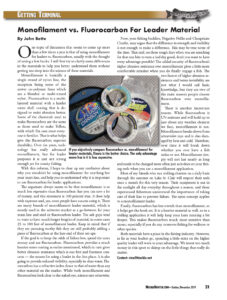Mono vs Fluoro
MHM Oct/Nov 2019 (Page 21) One topic of discussion that seems to come up more than a few times a year, is the topic of using monofilament for your leaders vs. fluorocarbon to help you save a few bucks. Before we really get into discussing things, I will try to clarify some differences in the materials to help you better understand things without getting too deep into the science of these materials. Monofilament is basically a single strand of nylon line, the exception being some of the newer co-polymer lines which are a blended or multi-strand nylon. Fluorocarbon is a multi-layered material with a harder outer shell coating that is designed to resist abrasion better than monofilament. Some of the chemicals used to make fluorocarbon are the same ones used to make Teflon, which I’m sure most everyone is familiar with. That is what helps give the fluorocarbon superior durability. Over the years, technology has really advanced monofilaments, but for leader purposes it is just not strong enough yet for us Musky fishermen. Hopefully, I can help clear up any confusion about why you shouldn’t be using mono for anything but your main line, and help you to understand why it is important to use fluorocarbon for your leader applications. Now the argument always seems to be that monofilament is so much less expensive than fluorocarbon that you can save a lot of money, which is 100% true. It does help with expenses, and yes, some people have success using it. There are many brands of mono leader material, which is mostly used in the saltwater market as a go between for your main line and steel or fluorocarbon leader. The salt guys tend to want to have much longer lengths of material, in some cases we are talking 25 to 100 feet of mono leader. However keep in mind if they are fishing for toothy fish they are still probably adding a hunk of fluorocarbon at the lure end of their set ups. Now if the goal is to help keep the odds of failure low, spend the extra money and use fluorocarbon. The length will be minimal and will protect those expensive lures. Fluorocarbon gives you a much heavier outer coating as we earlier mentioned, which in turn gives you better abrasion resistance which is our first and foremost concern. It is also going to give you better invisibility, especially in clear water. This is because fluorocarbon has a refractive index that is closer to the refractive index of water than any other material on the market. So while both mono and fluoro look clear to the naked eye, science tells us otherwise. Now your fishing buddies, Negative Nellie and Cheapskate Charlie, will argue that the difference in strength and invisibility is not enough to make a difference, which might be true some of the time. That said, on those tough days where you are searching for that one bite, don’t you want to have every advantage you could possibly have to help turn a bad day good? The added security of fluorocarbon’s higher abrasion resistance over monofilament gives you a little more comfortable mindset when you do finally engage a fish. The two factors of higher abrasion resistance and better invisibility are not what I would call basic knowledge, but they are two of the main reasons people choose fluorocarbon over monofilament. Now I will give you another reason as well. While fluorocarbon is UV resistant and will hold up in just about any weather element we face, mono is NOT. Monofilament breaks down from UV rays and is also damaged by heat and cold. Therefore, over time it will break down whether you ever have a fish strike or not. Mono will simply not last near as long and needs to be changed out more often just as it does on your fishing reels where you use a mono application. Most of my friends who run trolling charters on a daily basis through the summer over on Lake St. Clair will re-spool their reels once a month for this very reason. Their equipment is out in the sunlight all day everyday throughout a season, and these experienced fishermen understand the importance of taking care of their line to prevent failure. The same concept applies to a mono leader. Also, fluorocarbon has less stretch than mono so it gives you better hook setting ability. It is a heavier material as well, so in a trolling application it will help keep your lures running a bit deeper. This makes the fluoro much more sensitive than mono, especially if you do any crossover fishing for walleye or other species. Both materials have a place in the fishing industry. However, as far as your leaders go, spending a little extra on the higher quality leader can be to your advantage. Saving a few bucks isn’t always the way to go. We spend too much money in this sport to skimp on the little things that could ultimately turn a good day bad.

